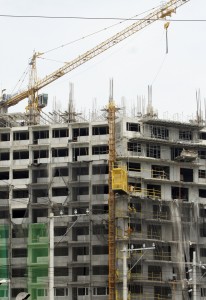
Workers climb scaffoldings of a building under construction on May 31, 2012, in Manila. The Asian Development Bank has raised the Philippines’ growth outlook for the country from 4.8 to 5.5 percent for 2012 while it scaled down its forecasts for other developing countries in the region. AP PHOTO/PAT ROQUE
MANILA, Philippines—The Asian Development Bank has cited the Philippines as one of the few exceptional cases in terms of economic expansion, raising its growth outlook for the country from 4.8 to 5.5 percent for 2012 while it scaled down its forecasts for other developing countries in the region.
In its latest “Asian Development Outlook” report, the increase in the growth projection for the Philippines took into account observations that the country was stronger than earlier anticipated in terms of withstanding the effects of global economic woes.
“The Philippine economy continues to show strength despite global and regional economic slowdown,” the ADB said in the report, which was released on Wednesday.
ADB cited the rise in investments by local firms, robust household consumption, and increase in government spending as factors behind the latest growth forecast.
For 2013, however, ADB expects the country to expand at a slower pace of 5 percent. This was anchored on expectation that demand from industrialized countries for exports from the Philippines would be weaker due to prolonged economic challenges confronting them.
For all developing countries in Asia, ADB cut its average growth forecast from 6.9 to 6.1 percent for this year, and from 7.3 to 6.7 percent for 2013.
China and India, which are the two biggest Asian economies, suffered from cuts in growth projections because they are believed to be hit more significantly by the crisis in the eurozone and the anemic performance of the United States.
China is now seen to grow by 7.7 percent for 2012 from an earlier projection of 8.5 percent. Moreover, it is now estimated to grow by 8.1 percent in 2013 from the previous forecast of 7.7 percent.
India is now expected to grow by just 5.6 percent this year from an earlier forecast of 7 percent. In addition, it is now seen to grow by 6.7 percent next year from the previous estimate of 7.5 percent.
“Developing Asia must adapt to a moderate growth environment, and countries will need to do more to reduce their reliance on exports, rebalance their sources of growth, and increase their productivity and efficiency,” Changyong Rhee, chief economist of ADB, said in a statement.
The United Sates and the eurozone are key export markets and major sources of foreign direct investments for many developing Asian economies. This is the reason the crisis in the eurozone and the lackluster performance of the United States are seen pulling down growth rates of the Asian countries.
Meanwhile, Neeraj Jain, ADB country director for the Philippines, said the favorable growth performance of the country would not mean absence of economic problems.
He said the key challenge for the Philippines has been to make its economic growth redound to poverty reduction. Despite its continually growing economy, Jain said, poverty has remained a serious problem.
“Despite growth, poverty incidence in the Philippines rose from 2003 to 2009. That is a cause for concern,” he said. Poverty rate stood at 24.9 percent in 2003 and 26.5 percent in 2009.
Jain said the country must implement policies that would attract investments in sectors that could provide jobs for the masses, especially those without college education.